Indian Pharmaceutical Market Size
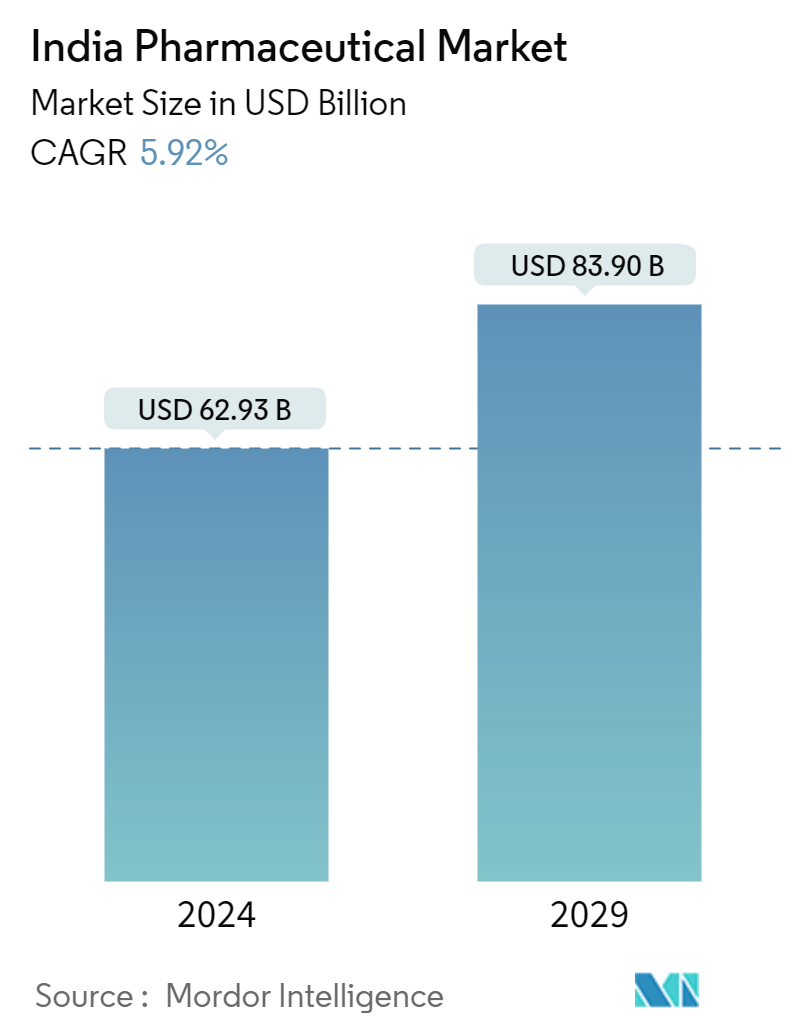
| Study Period | 2019 - 2029 |
| Base Year For Estimation | 2023 |
| Market Size (2024) | USD 62.93 Billion |
| Market Size (2029) | USD 83.90 Billion |
| CAGR (2024 - 2029) | 5.92 % |
| Market Concentration | Medium |
Major Players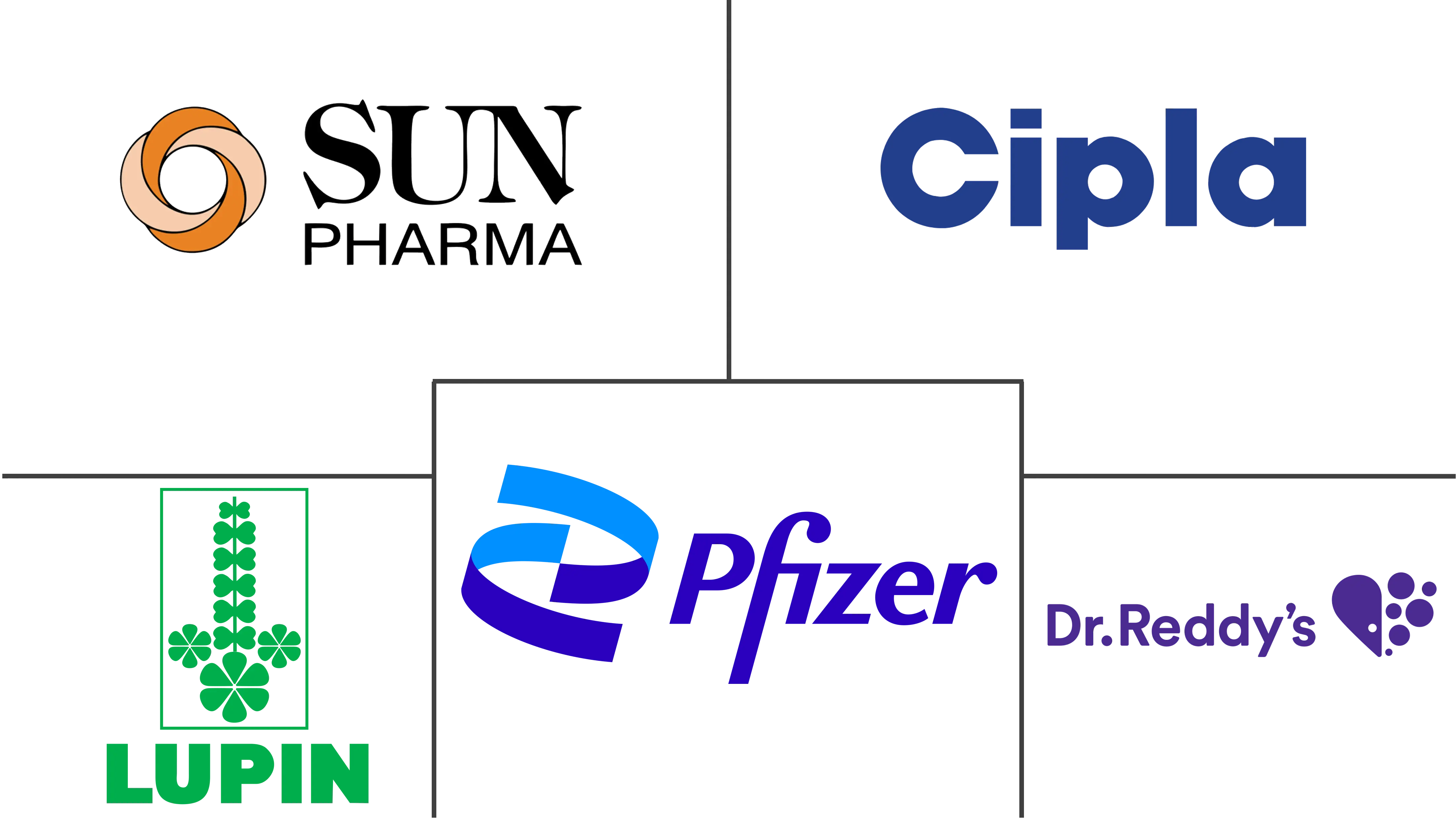
*Disclaimer: Major Players sorted in no particular order |
Need a report that reflects how COVID-19 has impacted this market and its growth?
Indian Pharmaceutical Market Analysis
The India Pharmaceutical Market size is estimated at USD 62.93 billion in 2024, and is expected to reach USD 83.90 billion by 2029, growing at a CAGR of 5.92% during the forecast period (2024-2029).
The Indian market witnessed a significant setback due to the outbreak of COVID-19. The growth of the Indian pharmaceutical industry was largely supported by government initiatives and programs. The COVID-19 flare-up also provided an opportunity for Indian pharmaceutical organizations to transform into a supported trade point for gathering drugs and intermediates. In April 2020, as the crisis deepened on a global level, the country lifted the restrictions on the export of 24 pharmaceutical ingredients and medicines. With the sudden emergence of COVID-19, there was a high and growing demand for vaccines as one of the most effective tools to protect against infectious diseases. For instance, in May 2021, under Atmanirbhar Bharat 3.0, Mission COVID Suraksha, the GOI accelerated the development and production of indigenous COVID vaccines "COVAXIN". The Department of Biotechnology, GOI, provided financial support in the form of a grant to vaccine manufacturing facilities for enhanced production capacities, which were expected to reach 10 crore doses per month by September 2021. For these, public-sector companies such as Haffkine Biopharmaceutical Corporation Ltd., IIL Hyderabad, and BIBCOL, Bulandshahr, received assistance from the government. Furthermore, in the post-pandemic scenario, the Indian pharmaceutical market is expected to witness healthy growth owing to the increased demand, digitalization, and surge in domestic production, according to the analysis. For instance, as per the IES 2021 report, in the next decade, the domestic market is expected to grow 3x, thereby boosting the pharmaceutical market over the next few years.
The Indian pharmaceutical sector has a long history of developing and delivering world-class products at affordable costs across the globe. As per IBEF data updated in June 2022, India has the greatest number of US FDA-approved units (741 as of August 2021). Indian pharma companies offer products in segments such as generic drugs, OTC medicines, active pharmaceutical ingredients (APIs), vaccines, contract research and manufacturing, and biosimilars and biologics. For another instance, in 2021, according to the IBEF, for 2021-22, the export of drugs and pharmaceutical products stood at USD 24.6 billion, compared to USD 24.4 billion in the years 2020-21. To encourage investment, the approval time for new facilities has been streamlined. Additionally, as per the same source, the United States is India's primary export market for pharmaceuticals. Moreover, India plays a very crucial role in the generic aspect of the global pharmaceutical industry. For instance, in 2021, India ranked 3rd in volume and 14th in value concerning pharmaceutical production in the global industry, and India supplied over 50% of the global demand for vaccines, 40% of generic demand in the United States, and 25% of all medicinal products in the United Kingdom.
Therefore, an increase in the export of generic medicine and increasing research and development activities will boost market growth over the forecast period. However, the lack of a stable pricing & policy environment and the lack of innovative drug development may hamper the growth of the studied market.
Indian Pharmaceutical Market Trends
The Respiratory Therapeutic Category Segment is Expected to Show Healthy Market Growth in the Forecast Period
Respiratory drugs commonly comprise of bronchodilators, corticosteroids, mast cell stabilizers, anti-IgE antibodies, leukotriene receptor antagonists, antivirals, pulmonary surfactants, and respiratory stimulants, among others.
Respiratory diseases are those that affect the respiratory tracts and the lungs. These diseases are caused by infection, smoking, tobacco, passive smoking, radon, asbestos, or other forms of air pollution. Common respiratory diseases include asthma, chronic obstructive pulmonary disease (COPD), pulmonary fibrosis, pneumonia, and lung cancer. The respiratory segment is anticipated to grow at a significant rate over the forecast period due to the rising burden of respiratory diseases and increasing air pollution, coupled with research and development in the field and the launch of new products in the Indian market.
For instance, in May 2021, the WHO reported that the self-reported prevalence of any diagnosed chronic lung disease among people aged 45-59 years was 6% in India. The most prevalent lung disease among this age group in India is asthma, which accounts for 4.4%, followed by COPD, which equals 2.1%, and bronchitis, with 1.1%. Such a high burden of diseases among age groups is leading the way toward the growth of the segment. Furthermore, in June 2022, Glenmark became the first pharmaceutical company to launch an indacaterol and mometasone fixed-dose combination drug for asthma in India. This is an innovative drug Indacaterol, a long-acting beta-agonist, and mometasone furoate, an inhaled corticosteroid that is approved by the DCGI.
Therefore, the respiratory therapy segment is expected to witness significant growth due to the rising burden of respiratory diseases and increasing air pollution, together with R&D activities and the introduction of newer drugs over the forecast period.
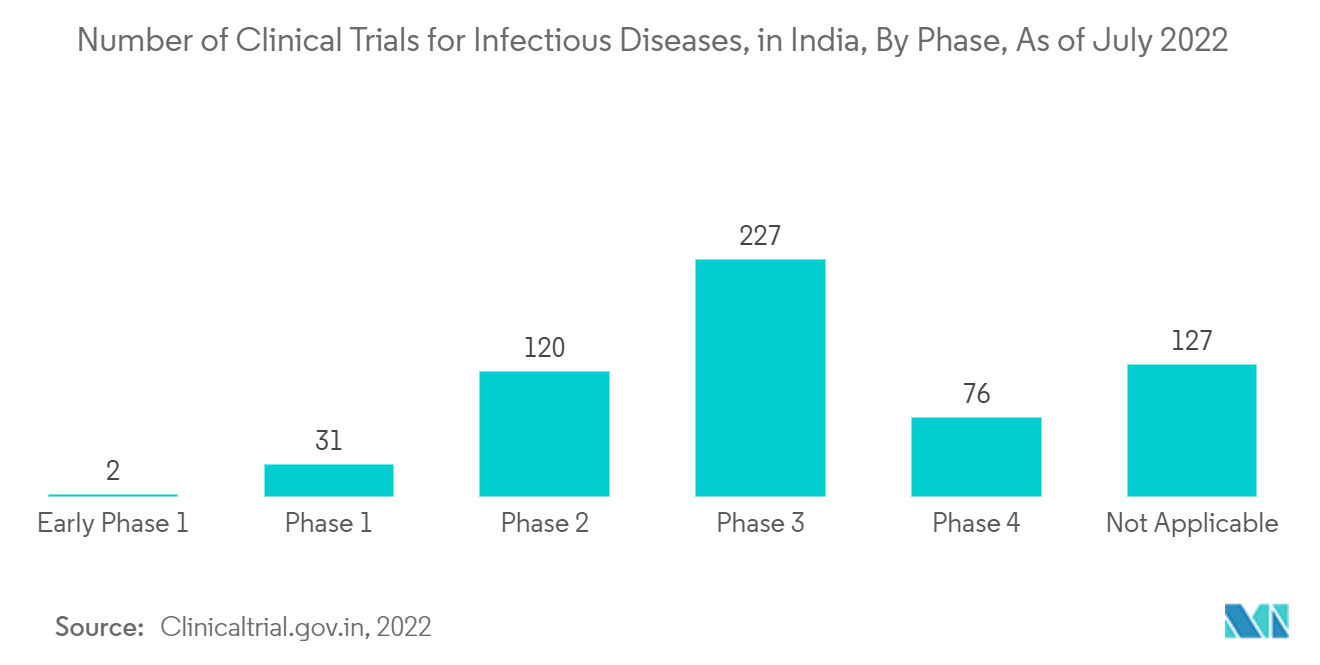
The Generic Drugs Segment is Expected to Show Healthy Market Growth in the Forecast Period
A generic drug is a medication created to be the same as an existing approved brand-name drug in dosage form, safety, strength, route of administration, quality, and performance characteristics. Generic drug manufacturers do not have to spend extra money on drug discovery and preclinical and clinical trials. Generics are available at a lower cost; they provide an opportunity for savings in drug expenditure in a country. Owing to such advantages of generic drugs coupled with low-cost manufacturing in the country, the segment is likely to project remarkable growth over the forecast period.
Furthermore, the presence of companies such as Alkem Laboratories, Sun Pharma, and Aurobindo Pharma Limited, among others, dealing in the generics segment, along with the growing dependence of other countries on Indian generics, is another factor responsible for boosting the segment's growth. For instance, as per IBEF data published in November 2021, India is the world's top supplier of generic pharmaceuticals. India supplies 40% of the generic demand in the United States and approximately 50% in Africa. The country has a 20% export share in the global generic medicine market by volume. About 8 out of 20 global generic companies are from India, and over 55% of the exports from the country are for highly regulated markets.
Moreover, as per the ICRA report, the GOI is planning to provide free generic medications to half of the Indian population through Pradhan Mantri Bhartiya Janaushadhi Kendras at an estimated cost of USD 5.4 billion. In addition, the officials in September 2021 stated that India is open to work with East Asian partners on the development of generic pharmaceuticals and medical technology for the treatment of COVID-19 patients and vaccine development. This will further lead to an increase in the production of generic drugs in collaboration with other East Asian companies, thereby propelling the segment's growth over the coming years.
Therefore, owing to the aforementioned factors, the generic segment is expected to witness growth at a faster pace over the forecast period.
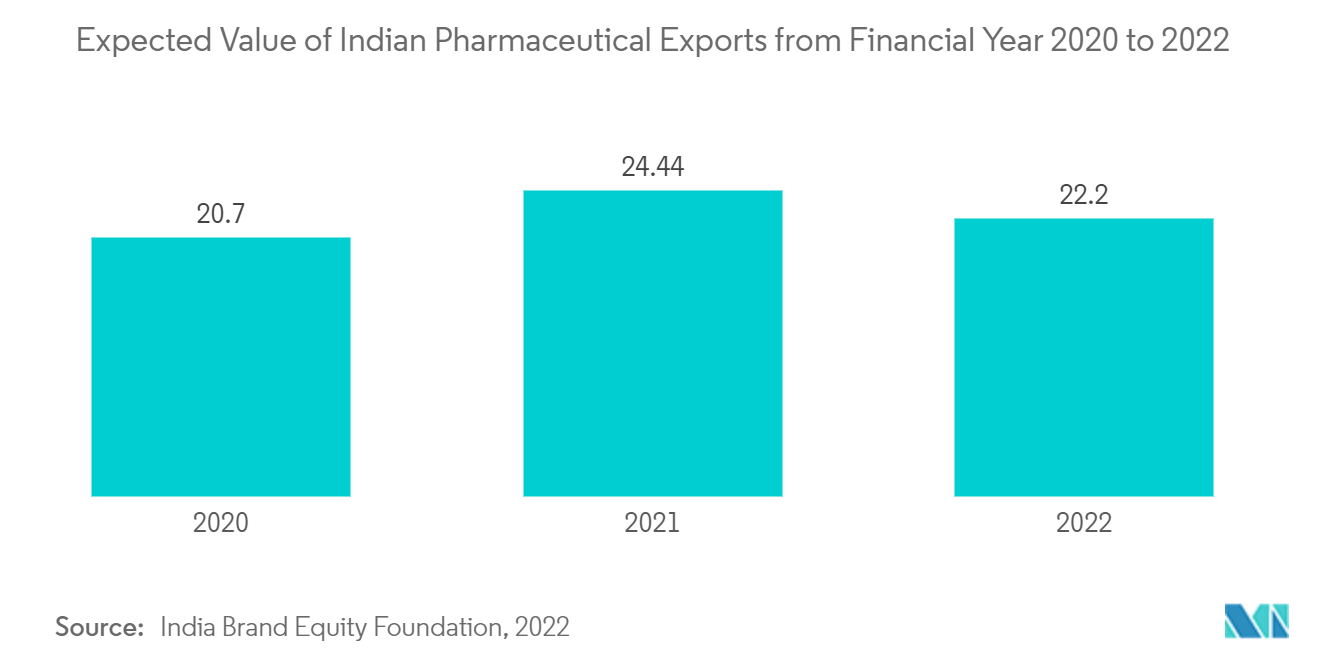
Indian Pharmaceutical Industry Overview
The India pharmaceutical market is fragmented in nature due to the presence of many companies operating globally as well as regionally. The competitive landscape includes an analysis of a few international as well as local companies that hold market shares and are well known, such as Cipla Inc., Dr. Reddy's Laboratories Ltd., Lupin, Sun Pharmaceutical Industries Ltd., Cadila Pharmaceuticals, GlaxoSmithKline, Biocon, Pfizer, Novartis AG, Merck & Co., Torrent Pharma, Divi's Laboratories, Aurobindo Pharma Limited, Mankind Pharma, and Abbott India.
Indian Pharmaceutical Market Leaders
-
Sun Pharmaceutical Industries Limited
-
Cipla Pharmaceuticals
-
Pfizer
-
Lupin
-
Dr. Reddy’s laboratories
*Disclaimer: Major Players sorted in no particular order
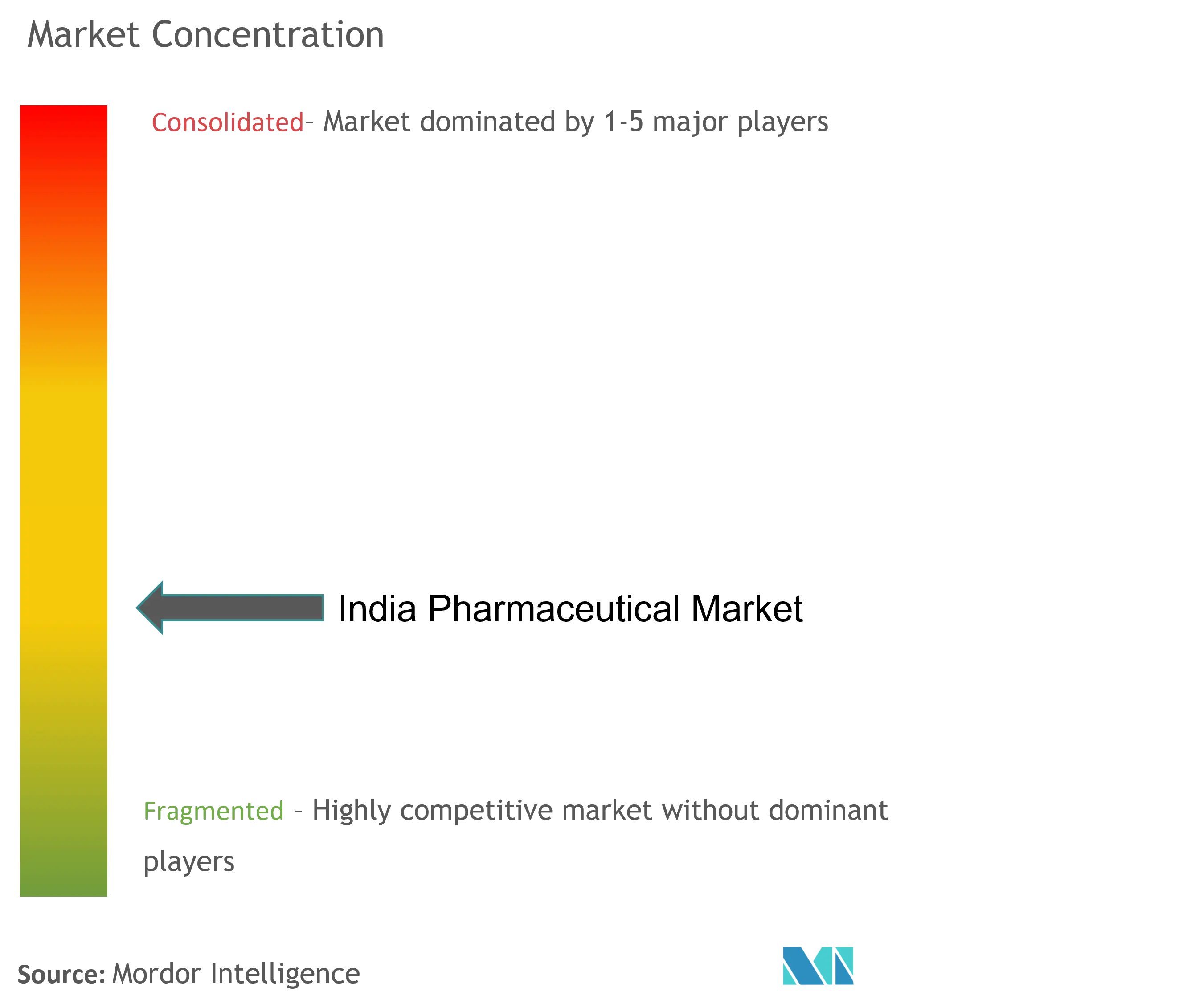
Indian Pharmaceutical Market News
- In February 2022, Dr. Reddy's Laboratories Ltd. announced that the Drugs Controller General of India (DCGI) had approved the single-shot Sputnik Light vaccine for restricted use in an emergency in India.
- In November 2021, Cipla Limited was granted EUA permission by the DCGI for the launch of Molnupiravir in India, the first oral antiviral approved by the United Kingdom Medicines and Healthcare Products Regulatory Agency (MHRA) for the treatment of mild-to-moderate COVID-19 at high risk of developing severe disease.
Indian Pharmaceutical Market Report - Table of Contents
1. INTRODUCTION
- 1.1 Study Assumptions and Market Definition
- 1.2 Scope of the Study
2. RESEARCH METHODOLOGY
3. EXECUTIVE SUMMARY
4. MARKET DYNAMICS
-
4.1 Market Overview
- 4.1.1 Healthcare Expenditure (Govt. Vs Private)
- 4.1.1.1 Pharmaceutical Imports and Exports
- 4.1.1.2 Epidemiology Data For key Diseases
- 4.1.1.3 Regulatory Landscape/Regulatory Bodies
- 4.1.1.4 Licensing and Market Authorization (For both Local Production and Imported Goods)
- 4.1.2 Pipeline Analysis
- 4.1.2.1 By Phase
- 4.1.2.2 By Sponsor
- 4.1.2.3 By Disease
- 4.1.3 Statistical Overview
- 4.1.3.1 Number of Hospitals
- 4.1.3.2 Employment in the Pharmaceutical Sector
- 4.1.3.3 R&D Expenditure
- 4.1.4 Ease of Doing Business
-
4.2 Market Drivers
- 4.2.1 Low Cost of Production and Increased R&D Activities
- 4.2.2 Increased Expenditure on Healthcare and Medicine
-
4.3 Market Restraints
- 4.3.1 Lack of a Stable Pricing and Policy Environment
- 4.3.2 Lack in Development of Innovative Drugs
-
4.4 Porter's Five Force Analysis
- 4.4.1 Threat of New Entrants
- 4.4.2 Bargaining Power of Buyers/Consumers
- 4.4.3 Bargaining Power of Suppliers
- 4.4.4 Threat of Substitute Products
- 4.4.5 Intensity of Competitive Rivalry
5. MARKET SEGMENTATION (Market Size by Value - USD million)
-
5.1 By Therapeutic Category
- 5.1.1 Anti-Infectives
- 5.1.2 Cardiovascular
- 5.1.3 Gastrointestinal
- 5.1.4 Anti Diabetic
- 5.1.5 Respiratory
- 5.1.6 Dermatologicals
- 5.1.7 Musculo-Skeletal System
- 5.1.8 Nervous System
- 5.1.9 Others
-
5.2 By Drug Type
- 5.2.1 Prescription Drug
- 5.2.1.1 Branded Drugs
- 5.2.1.2 Generic Drugs
- 5.2.2 OTC Drugs
6. COMPETITIVE LANDSCAPE
-
6.1 Company Profiles
- 6.1.1 Cipla Inc.
- 6.1.2 Dr. Reddy's Laboratories Ltd.
- 6.1.3 Lupin Limited
- 6.1.4 Sun Pharmaceutical Industries Ltd.
- 6.1.5 Cadila Pharmaceuticals
- 6.1.6 GlaxoSmithKline plc
- 6.1.7 Biocon Limited
- 6.1.8 Pfizer Inc
- 6.1.9 Novartis AG
- 6.1.10 Merck & Co., Inc.
- 6.1.11 Torrent Pharma.
- 6.1.12 Divi's Laboratories.
- 6.1.13 Aurobindo Pharma Limited
- 6.1.14 Mankind Pharma
- 6.1.15 Abbott
- *List Not Exhaustive
7. MARKET OPPORTUNITIES AND FUTURE TRENDS
** Subject To AvailablityIndian Pharmaceutical Industry Segmentation
As per the scope of this report, pharmaceuticals are referred to as prescribed and non-prescribed drugs used for medical purposes to cure, prevent, or control any therapeutic condition. The India Pharmaceutical Market is segmented by Therapeutic Category (Anti-Infectives, Cardiovascular, Gastrointestinal, Anti Diabetic, Respiratory, Dermatologicals, Musculo-Skeletal System, Nervous System, and Others) and Drug Type (Prescription Drugs (Branded Drugs and Generic Drugs), and Over Counter Drugs). The report offers the value (in USD million) for the above segments.
| By Therapeutic Category | Anti-Infectives | |
| Cardiovascular | ||
| Gastrointestinal | ||
| Anti Diabetic | ||
| Respiratory | ||
| Dermatologicals | ||
| Musculo-Skeletal System | ||
| Nervous System | ||
| Others | ||
| By Drug Type | Prescription Drug | Branded Drugs |
| Generic Drugs | ||
| By Drug Type | OTC Drugs |
Indian Pharmaceutical Market Research FAQs
How big is the India Pharmaceutical Market?
The India Pharmaceutical Market size is expected to reach USD 62.93 billion in 2024 and grow at a CAGR of 5.92% to reach USD 83.90 billion by 2029.
What is the current India Pharmaceutical Market size?
In 2024, the India Pharmaceutical Market size is expected to reach USD 62.93 billion.
Who are the key players in India Pharmaceutical Market?
Sun Pharmaceutical Industries Limited, Cipla Pharmaceuticals, Pfizer, Lupin and Dr. Reddy’s laboratories are the major companies operating in the India Pharmaceutical Market.
What years does this India Pharmaceutical Market cover, and what was the market size in 2023?
In 2023, the India Pharmaceutical Market size was estimated at USD 59.20 billion. The report covers the India Pharmaceutical Market historical market size for years: 2019, 2020, 2021, 2022 and 2023. The report also forecasts the India Pharmaceutical Market size for years: 2024, 2025, 2026, 2027, 2028 and 2029.
What are the key government initiatives driving India's Pharma Industry growth?
The key government initiatives driving India's Pharma Industry growth are a) Production Linked Incentive (PLI) schemes boost domestic manufacturing of critical drugs and APIs b) Bulk Drug Parks attract investments, ensuring drug security and reducing import dependence.
What are the key government initiatives driving India's Pharma Industry growth?
The key government initiatives driving India's Pharma Industry growth are a) Production Linked Incentive (PLI) schemes boost domestic manufacturing of critical drugs and APIs b) Bulk Drug Parks attract investments, ensuring drug security and reducing import dependence.
Indian Pharmaceutical Industry Report
The Indian pharmaceutical market is on the brink of significant growth, driven by escalating disease burden and supportive government policies. This market, which includes prescription drugs, over-the-counter medications, vaccines, and biologics, is set for considerable expansion. Enhanced healthcare access, India's large population, and increased R&D investments further bolster this sector. Government initiatives aimed at improving healthcare affordability and infrastructure play a crucial role in this growth.
The market's segmentation reveals a diverse product range, with pharmaceutical drugs being the predominant segment, highlighting traditional manufacturing and research practices. The Indian pharmaceutical sector, known for its comprehensive presence across the country, addresses varied healthcare needs, driven by growing health awareness and government support.
Industry analysis shows that key players, including Cipla Inc., Dr. Reddy's Laboratories Ltd., Lupin, and Sun Pharmaceutical Industries Ltd., are pivotal in this market. Industry trends indicate that respiratory and generic drugs are showing strong growth. Market research emphasizes the potential for substantial growth and the market's pivotal role in meeting healthcare demands.
Market overview and market segmentation highlight the importance of understanding different therapeutic categories and pill types. Market forecast and market growth projections underscore the robust future of the Indian pharmaceutical market. Industry statistics and industry size data provide insights into the market's scale and potential.
Industry reports and research companies offer detailed insights and future projections. Market leaders play a significant role in shaping the industry landscape. Market outlook and market value are crucial for understanding the economic impact of this sector. The industry outlook remains positive, with a focus on affordability and top-tier medications.
Report PDFs and report examples are valuable resources for stakeholders. Market data, market predictions, and market review help in comprehending the market dynamics. The industry's growth rate is expected to remain strong, driven by increased demand and digitalization. Industry information and industry research are essential for staying updated with the latest developments. Industry sales and industry worth reflect the market's financial health.
In summary, the Indian pharmaceutical market is poised for robust growth, supported by government initiatives, increased health awareness, and a strong focus on affordable, high-quality medications. This market's expansion is a testament to its critical role in addressing the healthcare needs of a growing population.

